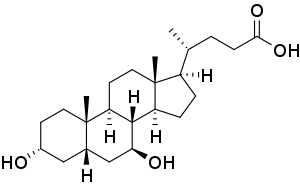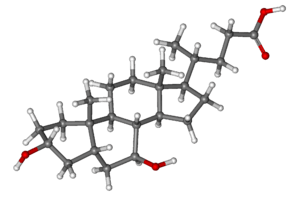Ursodeoxycholic acid
Ursodeoxycholic acid (UDCA), also known as ursodiol, is a secondary bile acid, produced in humans and most other species from metabolism by intestinal bacteria. It is synthesized in the liver in some species, and was first identified in bear bile, which is the derivation of its name Ursus. In purified form, it has been used to treat or prevent several diseases of the liver or bile ducts.
 | |
 | |
| Clinical data | |
|---|---|
| Trade names | Actigall, Urso, others |
| Other names | Ursodiol |
| AHFS/Drugs.com | Monograph |
| MedlinePlus | a699047 |
| License data | |
| Pregnancy category | |
| Routes of administration | By mouth |
| ATC code | |
| Legal status | |
| Legal status | |
| Identifiers | |
| |
| CAS Number | |
| PubChem CID | |
| IUPHAR/BPS | |
| DrugBank | |
| ChemSpider | |
| UNII | |
| KEGG | |
| ChEBI | |
| ChEMBL | |
| PDB ligand | |
| CompTox Dashboard (EPA) | |
| ECHA InfoCard | 100.004.437 |
| Chemical and physical data | |
| Formula | C24H40O4 |
| Molar mass | 392.56 g·mol−1 |
| 3D model (JSmol) | |
| Melting point | 203 °C (397 °F) |
| |
| |
| (verify) | |
Medical uses
UDCA has been used as medical therapy in gallstone disease (cholelithiasis) and for biliary sludge.[3][4] UDCA helps reduce the cholesterol saturation of bile and leads to gradual dissolution of cholesterol-rich gallstones.[3]
UDCA may be given after bariatric surgery to prevent cholelithiasis, which commonly occurs due to the rapid weight loss producing biliary cholesterol oversaturation and also biliary dyskinesia secondary hormonal changes.[5]
Primary biliary cholangitis
UDCA is used as therapy in primary biliary cholangitis (PBC; previously known as primary biliary cirrhosis) where it can produce an improvement in biomarkers.[6] Meta-analyses have borne out conflicting results on the mortality benefit.[7] However analyses that exclude trials of short duration (i.e. < 2 years) have demonstrated a survival benefit and are generally considered more clinically relevant.[8] A Cochrane systematic review in 2012 found no significant benefit in reducing mortality, the rate of liver transplantation, pruritus or fatigue.[9] Ursodiol is the only FDA approved drug to treat PBC but many patients do not respond; other treatments are under study.[10]
Primary sclerosing cholangitis
UDCA use is associated with improved serum liver tests that do not always correlate with improved liver disease status.[11] WHO Drug Information advises against its use in primary sclerosing cholangitis in unapproved doses beyond 13–15 mg/kg/day.[12]
Intrahepatic cholestasis of pregnancy
UDCA has been used for intrahepatic cholestasis of pregnancy. UDCA lessens itching in the mother and may reduce the number of preterm births. Effects on fetal distress and other adverse outcomes are unlikely to be great.[13][14]
Cholestasis
UDCA use is not licensed in children, as its safety and effectiveness have not been established. Evidence is accumulating that ursodeoxycholic acid is ineffective and unsafe in neonatal hepatitis and neonatal cholestasis.[15][16][17]
Other conditions
UDCA has been suggested to be an adequate treatment of bile reflux gastritis.[18]
In cystic fibrosis there is insufficient evidence to justify routine use of UDCA, especially as there is a lack of available data for long-term outcomes such as death or need for liver transplantation.[19]
UDCA has also been used in non-alcoholic fatty liver disease, in liver bile duct-paucity syndromes such as biliary atresia, liver allograft rejection, and in Graft-versus-host disease involving the liver.
Adverse effects
Diarrhea was the most frequent adverse event seen in trial of UDCA in gallstone dissolution, occurring in 2 to 9%, which is less frequent than with chenodeoxycholic acid therapy. Bacterial conversion of UDCA to chenodeoxycholic acid may be the mechanism for this side effect. Right upper quadrant abdominal pain and exacerbation of pruritus was occasionally reported in trials in patients with PBC.[20]
Mechanisms of action
Choleretic effects
Primary bile acids are produced by the liver and stored in the gall bladder. When secreted into the intestine, primary bile acids can be metabolized into secondary bile acids by intestinal bacteria. Primary and secondary bile acids help the body digest fats. Ursodeoxycholic acid helps regulate cholesterol by reducing the rate at which the intestine absorbs cholesterol molecules while breaking up micelles containing cholesterol. The drug reduces cholesterol absorption and is used to dissolve (cholesterol) gallstones in patients who want an alternative to surgery.[21] There are multiple mechanisms involved in cholestatic liver diseases.[22]
Immunomodulating effects
Ursodeoxycholic acid has also been shown experimentally to suppress immune response such as immune cell phagocytosis. Prolonged exposure and/or increased quantities of systemic (throughout the body, not just in the digestive system) ursodeoxycholic acid can be toxic.[23]
Anti-inflammatory effects
Ursodeoxycholic acid has been shown to exert anti-inflammatory and protective effects in human epithelial cells of the gastrointestinal tract. It has been linked to regulation of immunoregulatory responses by regulation of cytokines,[24] antimicrobial peptides defensins,[25] and take an active part in increased restitution of wound in the colon.[26] Moreover, UDCA's effects has been shown to have exert actions outside the epithelial cells.[27]
While some bile acids are known to be colon tumor promoters (e.g. deoxycholic acid), others such as ursodeoxycholic acid are thought to be chemopreventive, perhaps by inducing cellular differentiation and/or cellular senescence in colon epithelial cells.[28]
Names
The term is from the Latin noun ursus meaning bear, as bear bile contains the substance.
Ursodeoxycholic acid can be chemically synthesized and is marketed under multiple trade names, including Ursetor, Udikast, Actibile, Actigall, Biliver, Deursil, Egyurso, Udcasid, Udiliv, Udinorm, Udoxyl, Urso, Urso Forte, Ursocol, Ursoliv, Ursofalk, Ursosan, Ursoserinox, Udimarin, Ursonova, and Stener.
History
Ursodeoxycholic acid was approved for use in the United States in December 1987,[29] and was designated an orphan drug.[30]
See also
References
- "Ursodiol Use During Pregnancy". Drugs.com. 4 November 2019. Retrieved 20 February 2020.
- "Ursodeoxycholic acid 300mg Tablets - Summary of Product Characteristics (SmPC)". (emc). 10 July 2019. Retrieved 29 April 2020.
- Hofmann, AF (September 1989). "Medical dissolution of gallstones by oral bile acid therapy". American Journal of Surgery. 158 (3): 198–204. doi:10.1016/0002-9610(89)90252-3. PMID 2672842.
- Jüngst, C; Kullak-Ublick, GA; Jüngst, D (2006). "Gallstone disease: Microlithiasis and sludge". Best Practice & Research. Clinical Gastroenterology. 20 (6): 1053–62. doi:10.1016/j.bpg.2006.03.007. PMID 17127187.
- Magouliotis, DE; Tasiopoulou, VS; Svokos, AA; Svokos, KA; Chatedaki, C; Sioka, E; Zacharoulis, D (November 2017). "Ursodeoxycholic Acid in the Prevention of Gallstone Formation After Bariatric Surgery: an Updated Systematic Review and Meta-analysis". Obesity Surgery. 27 (11): 3021–3030. doi:10.1007/s11695-017-2924-y. PMID 28889240.
- Poupon, RE; Balkau, B; Eschwège, E; Poupon, R (30 May 1991). "A multicenter, controlled trial of ursodiol for the treatment of primary biliary cirrhosis. UDCA-PBC Study Group". The New England Journal of Medicine. 324 (22): 1548–54. doi:10.1056/NEJM199105303242204. PMID 1674105.
- Goulis, J; Leandro, G; Burroughs, AK (25 September 1999). "Randomised controlled trials of ursodeoxycholic-acid therapy for primary biliary cirrhosis: a meta-analysis". Lancet. 354 (9184): 1053–60. doi:10.1016/S0140-6736(98)11293-X. PMID 10509495.
- Shi J, Wu C, Lin Y, Chen YX, Zhu L, Xie WF (July 2006). "Long-term effects of mid-dose ursodeoxycholic acid in primary biliary cirrhosis: a meta-analysis of randomized controlled trials". The American Journal of Gastroenterology. 101 (7): 1529–38. PMID 16863557.
- Rudic JS, Poropat G, Krstic MN, Bjelakovic G, Gluud C (December 2012). "Ursodeoxycholic acid for primary biliary cirrhosis". The Cochrane Database of Systematic Reviews. 12: CD000551. doi:10.1002/14651858.CD000551.pub3. PMC 7045744. PMID 23235576.
- Bowlus CL, Kenney JT, Rice G, Navarro R (October 2016). "Primary Biliary Cholangitis: Medical and Specialty Pharmacy Management Update". Journal of Managed Care & Specialty Pharmacy. 22 (10–a–s Suppl): S3–S15. doi:10.18553/jmcp.2016.22.10-a-s.s3. PMID 27700211.
- Poropat, G; Giljaca, V; Stimac, D; Gluud, C (19 January 2011). "Bile acids for primary sclerosing cholangitis". The Cochrane Database of Systematic Reviews (1): CD003626. doi:10.1002/14651858.CD003626.pub2. PMC 7163275. PMID 21249655.
- "Ursodeoxycholic acid: serious hepatic events" (PDF). WHO Drug Information. 26 (1). 2012.
- Gurung, Vinita; Stokes, Michael; Middleton, Philippa; Milan, Stephen J; Hague, William; Thornton, Jim G (2013). "Interventions for treating cholestasis in pregnancy". Cochrane Database of Systematic Reviews (6): CD000493. doi:10.1002/14651858.CD000493.pub2. ISSN 1465-1858. PMC 7043272. PMID 23794285.
- Chappell, LC; Bell, JL; Smith, A; Linsell, L; Juszczak, E; Dixon, PH; Chambers, J; Hunter, R; Dorling, J; Williamson, C; Thornton, JG; PITCHES study, group. (7 September 2019). "Ursodeoxycholic acid versus placebo in women with intrahepatic cholestasis of pregnancy (PITCHES): a randomised controlled trial". Lancet. 394 (10201): 849–860. doi:10.1016/S0140-6736(19)31270-X. PMC 6739598. PMID 31378395.
- Kotb MA (July 2008). "Review of historical cohort: ursodeoxycholic acid in extrahepatic biliary atresia". Journal of Pediatric Surgery. 43 (7): 1321–7. doi:10.1016/j.jpedsurg.2007.11.043. PMID 18639689.
- Paediatric Formulary Committee (2008). British National Formulary for Children 2008. London: Pharmaceutical Press. p. 91. ISBN 978-0-85369-780-0.
- "Urso package insert" (PDF). Birmingham, AL: Axcan Pharma U.S. January 2000.
- McCabe ME 4th, Dilly CK (2018). "New Causes for the Old Problem of Bile Reflux Gastritis". Clin Gastroenterol Hepatol. 16 (9): 1389–1392. doi:10.1016/j.cgh.2018.02.034. hdl:1805/15771. PMID 29505908.CS1 maint: uses authors parameter (link)
- Cheng K, Ashby D, Smyth RL (September 2017). Cochrane Cystic Fibrosis and Genetic Disorders Group (ed.). "Ursodeoxycholic acid for cystic fibrosis-related liver disease". The Cochrane Database of Systematic Reviews. 9: CD000222. doi:10.1002/14651858.CD000222.pub4. PMC 6483662. PMID 28891588.
- Hempfling, W; Dilger, K; Beuers, U (15 November 2003). "Systematic review: ursodeoxycholic acid--adverse effects and drug interactions". Alimentary Pharmacology & Therapeutics. 18 (10): 963–72. doi:10.1046/j.1365-2036.2003.01792.x. PMID 14616161.
- Tint, GS; Salen, G; Shefer, S (October 1986). "Effect of ursodeoxycholic acid and chenodeoxycholic acid on cholesterol and bile acid metabolism". Gastroenterology. 91 (4): 1007–18. doi:10.1016/0016-5085(86)90708-0. PMID 3527851.
- Paumgartner, G; Beuers, U (September 2002). "Ursodeoxycholic acid in cholestatic liver disease: mechanisms of action and therapeutic use revisited". Hepatology (Baltimore, Md.). 36 (3): 525–31. doi:10.1053/jhep.2002.36088. PMID 12198643.
- Material Safety Data Sheet on Ursodiol MSDS. https://fscimage.fishersci.com/msds/70916.htm
- Ward JB, Lajczak NK, Kelly OB, O'Dwyer AM, Giddam AK, Ní Gabhann J, Franco P, Tambuwala MM, Jefferies CA, Keely S, Roda A, Keely SJ (June 2017). "Ursodeoxycholic acid and lithocholic acid exert anti-inflammatory actions in the colon". American Journal of Physiology. Gastrointestinal and Liver Physiology. 312 (6): G550–G558. doi:10.1152/ajpgi.00256.2016. PMID 28360029.
- Lajczak NK, Saint-Criq V, O'Dwyer AM, Perino A, Adorini L, Schoonjans K, Keely SJ (September 2017). "Bile acids deoxycholic acid and ursodeoxycholic acid differentially regulate human β-defensin-1 and -2 secretion by colonic epithelial cells". FASEB Journal. 31 (9): 3848–3857. doi:10.1096/fj.201601365R. PMID 28487283.
- Mroz MS, Lajczak NK, Goggins BJ, Keely S, Keely SJ (March 2018). "The bile acids, deoxycholic acid and ursodeoxycholic acid, regulate colonic epithelial wound healing". American Journal of Physiology. Gastrointestinal and Liver Physiology. 314 (3): G378–G387. doi:10.1152/ajpgi.00435.2016. PMID 29351391.
- O'Dwyer AM, Lajczak NK, Keyes JA, Ward JB, Greene CM, Keely SJ (August 2016). "Ursodeoxycholic acid inhibits TNFα-induced IL-8 release from monocytes". American Journal of Physiology. Gastrointestinal and Liver Physiology. 311 (2): G334–41. doi:10.1152/ajpgi.00406.2015. PMID 27340129.
- Akare S, Jean-Louis S, Chen W, Wood DJ, Powell AA, Martinez JD (December 2006). "Ursodeoxycholic acid modulates histone acetylation and induces differentiation and senescence". International Journal of Cancer. 119 (12): 2958–69. doi:10.1002/ijc.22231. PMID 17019713.
- "Actigall: FDA-Approved Drugs". U.S. Food and Drug Administration (FDA). Retrieved 29 April 2020.
- "Actigall Orphan Drug Designation and Approval". U.S. Food and Drug Administration (FDA). Retrieved 29 April 2020.
External links
- "Ursodiol". Drug Information Portal. U.S. National Library of Medicine.
- Ursodeoxycholic acid in the British National Formulary (BNF is only available in the UK)